DOUBLE RIFLES OLD AND NEW
The double-barreled rifle is part of the lore and legend of African hunting. We call to mind Robert Ruark’s .470, J.A. Hunter’s .500, or Captain Jimmy Sutherland’s pair of .577s. Nothing is as fast or as foolproof-reliable for a life-saving second shot. In the golden days of safari, not all the great African hunters carried doubles, but a big double was the primary choice of most professional hunters in pursuit of dangerous game, and it is again today.
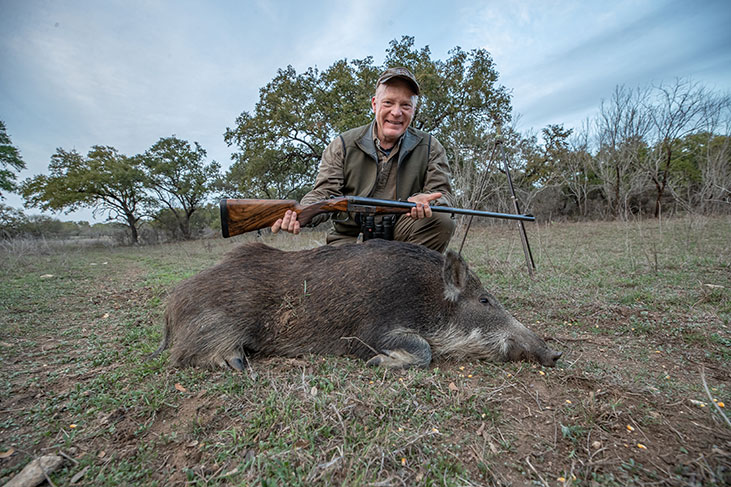
FORM AND SUBSTANCE
The most classic form of the double rifle has been a large-caliber side-by-side, although neither are absolute. In large calibers, over/unders are uncommon. In part, this is because they are generally heavier and must be opened through a much greater arc to reload. However, they exist; in Zambia in 1983, in a time when all double rifles were uncommon, my PH, Bill Illingsworth had a gorgeous over/under .470.
Bores like tunnels and cartridges like cigars are also not mandatory. Joof Lamprecht had a Heym .300 Winchester Magnum double that was amazingly accurate. Many doubles have been made in 9.3mms and .375. Many Europeans use doubles in lighter cartridges for driven shooting. I’ve got an old double in .303 British that I’ve been having a ball shooting pigs with.
All the repeating rifle actions have been with us since 1900. The double is the costliest and the least accurate, this last because of the physical impossibility of getting the two barrels to shoot perfectly together. It is the most easily sized for the largest cartridges. Long before smokeless powder, the double rifle evolved as an ideal choice for hunting dangerous game, where ranges are short, thus extreme accuracy means nothing; and because of the almost foolproof reliability of a quick second chance.
So, most doubles built today are chambered to powerful cartridges. Because of range and accuracy, a double rifle wouldn’t be my primary choice for any non-dangerous game, but they remain excellent for thick-skinned dangerous game. However, let’s be clear: Neither you nor I, as visiting pilgrims, must have a double rifle to hunt Africa. We will be just as successful all the way up to elephant with an appropriately-chambered bolt-action at ten percent the cost.
The folks who need doubles are probably those who can least afford them, PHs who, in a single season, pursue more dangerous game than we will in decades. Mostly they aren’t hunting with their doubles, they’re carrying them just in case. They use them only if we mess up, often a close, tense and sometimes desperate encounter. Exactly the kind of thing the big-bore double is best at sorting out. Few visiting sportsmen face such a situation.
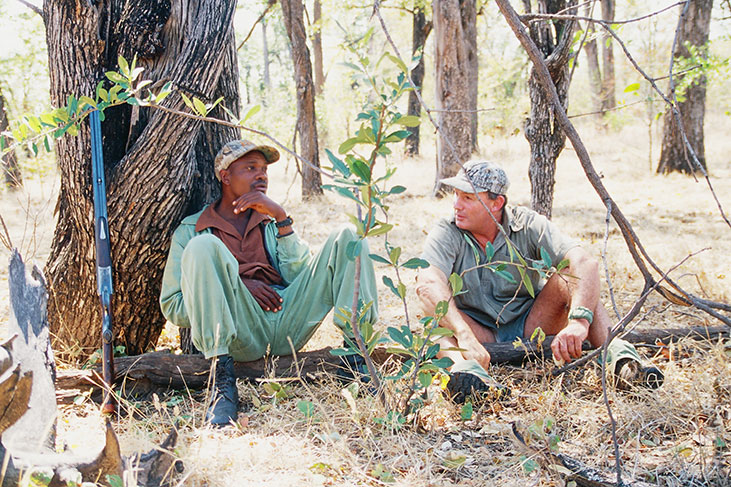
There are many nuances, but the basic differences between doubles can be boiled down to: Exposed or internal hammers; boxlock or sidelock; extractor or ejector. The exposed hammer gun is older, but some early hunters preferred hammers so they were made into the 1920s. They are made today, though primarily in basic doubles such as .45-70 (which, with the right loads, is buffalo-capable). I have little experience with exposed hammers, using one would take practice. The main drawback is they’re a bit slower, as cocking the hammers requires an extra step.
Sidelocks are often “fine guns,” while the boxlock is usually more basic. In the sidelock, the “works” are on the sides; the boxlock’s springs and hammers are “boxed” in the action. This makes the sidelock easier to access for service, but if you’re gonna mess with a double gun’s innards you’d best know what you’re doing. I have no preference between them and don’t think there’s a difference in strength or reliability. Many embellished boxlocks have sideplates, which are just a vehicle for engraving. Most new doubles are boxlock guns; sidelocks are still made, but are usually costly.
In extractor guns, fired cases are lifted from the chamber, but must be manually removed. Ejectors throw the cases clear, so reloading is faster, but not by much. With low-pressure Nitro Express cartridges, one can usually twist an extractor gun to the side and dump the fired cases. Ejectors are more complicated and usually take handwork to properly time. In older rifles, ejectors carry a premium over extractor guns. Most of my early doubles were extractor guns, because they were cheaper. Today I’m spoiled and have ejector guns but, with practice, I never felt hampered by extractors.
ALMOST GONE
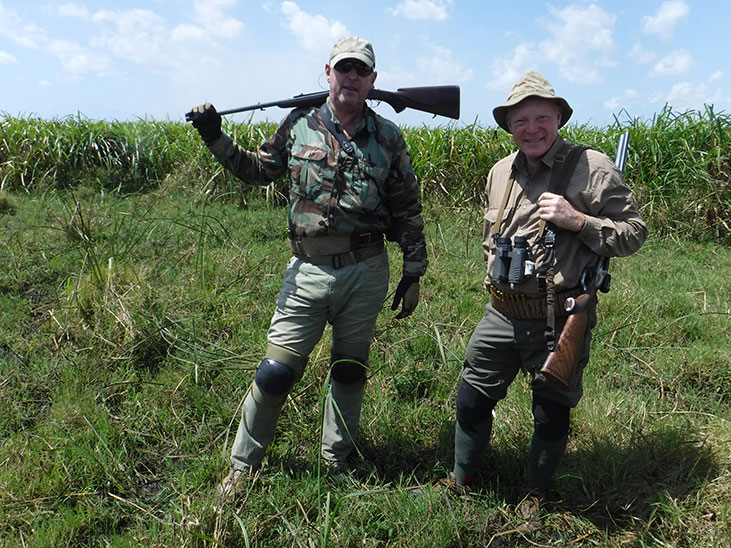
Britain’s Kynoch was the primary source for Nitro Express ammo. After WWII, as the British Empire shrank, Kynoch began discontinuing the large calibers. Least popular went first, but by the early 1960s only hoarded supplies remained. Across Africa and India hunters abandoned their doubles when they ran out of ammo. The .458 Winchester Magnum came in at exactly the right time. Inexpensive rifles and cheap, plentiful ammo.
Doubles could be had for peanuts and American handloaders could feed them. This did little for PHs in the field. When I started hunting in Africa doubles were unusual. I can count on the fingers of one hand the doubles I saw in use into the mid-Eighties.
The .458 was almost universal. In the early Eighties Jim Bell (Brass Extrusion Laboratories Limited) offered new cases. Barnes made the bullets, RCBS made the dies, and the double didn’t die. Heym’s Model 88B was probably the first “new” and affordable double marketed in the U.S., followed by Krieghoff and Merkel. American riflesmith Butch Searcy made a lot of doubles, as many any single small shop. Searcy guns are generally plain but stout and serviceable. His advertisement was “the dream of a double.” He made that dream come true for many.
I’ve had one or another double since 1979. I love them, but I don’t really need a double and neither do most of you. Over the last 25 years, I’ve been amazed at how many PHs, including youngsters, have gravitated back to the double rifle and done whatever was necessary to buy one. They think such rifle is an essential tool of the trade because it just might save lives.
A couple of years ago I hunted buffalo in Limpopo with Diekie Muller. Muller used to carry a Ruger No. One, not a common PH rifle. Robin Hurt advised him to get a double. He listened (and convinced his wife) so, when we hunted, he had a new Krieghoff .470. My bull took a step as I shot and I hit too far back. We were on it all day and into the next, and we’d lost the trail. I stayed with a tracker, trying to find the spoor while Diekie looped ahead. Minutes later we heard the double boom of his .470. The bull was down, sharp horns six paces from Diekie’s shoelaces. That’s why PHs carry doubles.
NEW OR OLD?
I love the look and feel of vintage English guns, but the guns are getting old. Most English doubles were made from 1900 to 1939. In 1980 such rifles averaged 50 years old, now they’re closing on a century. A few years ago, prices for big-bore English guns were through the roof. Since then, perhaps because of ivory importation issues and Botswana’s closure, prices have fallen considerably, especially for boxlock guns. Regardless of price, a classic hundred-year-old double is no longer a PH’s “working rifle.”
Today’s PHs mostly acquire new guns. The German firms got into the English-speaking market first, but Chapuis and Verney-Carron, respected French companies, make excellent doubles. The great English houses are making fantastic double rifles, and there are good Italian doubles across the price spectrum.
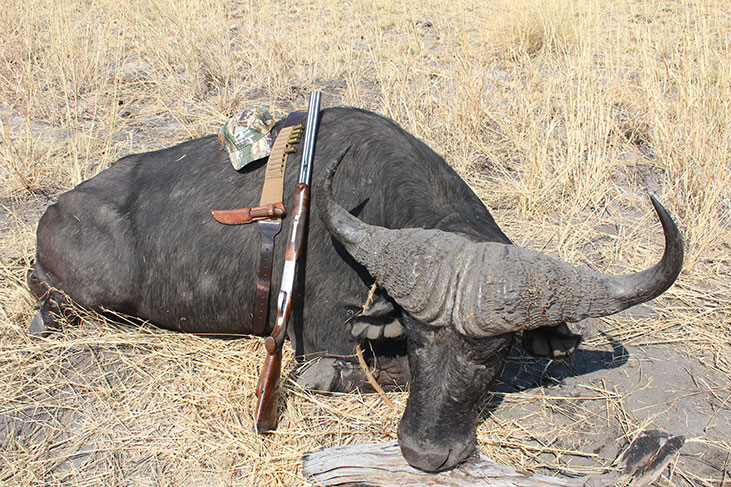
I have Sabatti doubles in 9.3x74R and .450 3 ¼-inch, nicely made, well-regulated and inexpensive. If you or I crave an older double to take on safari, that’s one thing. A PH will carry his double daily, good weather and bad. A sad fate for rifles that should be preserved and passed along. The market goes up and down, but every year there are fewer vintage doubles in serviceable condition.
From a practical standpoint, older doubles also have aging springs and metallurgy. New rifles are of modern steel and components machined to closer tolerances. I long coveted “one more” English double, so I bought a 1906 William Evans .470. I will take it on safari, but I’m gonna be careful. For harder use, I have Heym, Krieghoff and Sabatti in different cartridges. Good guns all, not inexpensive, but not irreplaceable.
SIGHTS
Open “express” sights are most common and this is the greatest limitation. When we get bitten by the Africa bug, an unavoidable symptom is hero worship of our PHs. Most carry iron-sighted doubles, so that’s what we should have, right? Remember, the PH’s purpose is different, his rifle will only be used when things go awry, usually up close and personal.
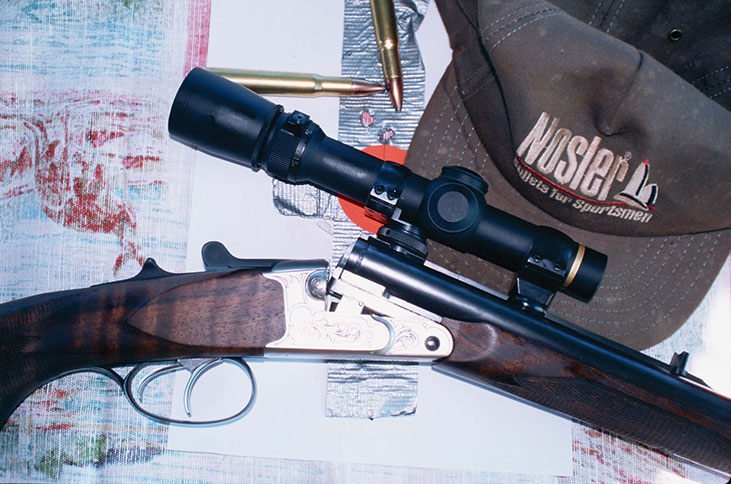
Most of us are accustomed to telescopic sights and, on safari, a riflescope will yield the best results. For big stuff, a red-dot sight is a good alternative and far superior to express sights. Because they are non-traditional, I resisted putting optics on doubles until I could no longer see iron sights well enough to use them effectively.
Some older rifles were fitted with detachable scopes and my .303 has a pop-up aperture on the tang. Such conveniences are uncommon. Because modification reduces collector value, I don’t recommend scoping older guns that weren’t built for them. My Wm Evans has traditional express sights and will stay that way, but it has a large pop-up “night sight” bead on the front sight. That’s what I shoot it with. I have to keep shots close. Recent doubles were manufactured in the scope age and most are more or less adaptable to optical sights. I don’t have experience with all the current makes, but I’ve used low-powered scopes and Aimpoints on Heym, Krieghoff and Sabatti. Optical sights open a new world of versatility for double rifles.
SHOOTING TIPS
With a side-by-side, under recoil the right barrel rolls right, left barrel rolls left. Regulation compensates for this by attaching the barrels with a slight degree of convergence. It is thus important that the double always be fired so the barrels can recoil naturally, avoiding a fixed rest that “harnesses” the rifle. It’s okay to use sandbags or a padded rest but, instead of directly resting the fore-end, grasp it with your supporting hand, and rest the hand and wrist over the bag. With shooting sticks, accuracy will likewise usually be better if you grasp the fore-end and then put hand and rifle together onto the junction of the sticks.
Part of the double’s legend for reliability is the redundancy of two separate locks. So, most double rifles have two triggers, although single triggers were offered and can often be retro-fitted. The most common arrangement: Right trigger is forward and fires the right barrel; the left trigger is about an inch behind it, to the left, and fires the left barrel. The preferred technique is to fire the front trigger first, then move the trigger finger to the rear trigger.
This trigger placement is actually the right-handed trigger arrangement because the rear trigger is offset to the left, making it less likely to inadvertently hit it during recoil and initiate a sequential double discharge (which is most unpleasant). For lefties, trigger placement (and barrel firing order) can be reversed on most doubles. I’m a lefty, and my Krieghoff .500 has the triggers reversed: Front trigger to left, firing left barrel; rear trigger to right, firing right barrel.
This is the only double I’ve ever had with “left-hand triggers.” Fortunately, I don’t have a problem hitting the rear trigger during recoil. Some shooters do and it’s serious. If it happens even once, try to focus on keeping your trigger finger away from the rear trigger during recoil. If it keeps happening, the only sure cure I know is to reverse the firing order: Rear trigger first, then shifting to forward trigger. Many double-gun shooters do it this way. No harm, except rear trigger first takes more hand movement, so is milliseconds slower.
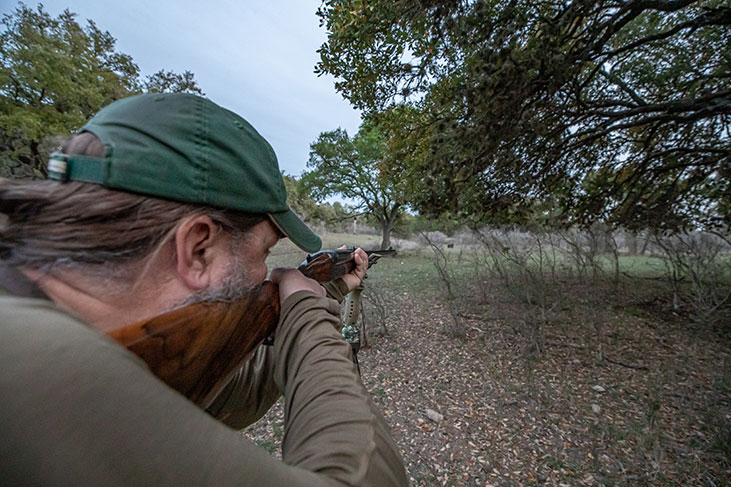
Either way, with large calibers (and especially with large hands), there is some chance the rear of the front trigger will bark your trigger finger when firing the rear trigger and the rear of the triggerguard bow can bark your middle finger. The latter can be cured with a bit of padding behind the bow, but the best solution is to work on a good, firm grip on the pistolgrip with your shooting hand. Few double rifles have been made with an “English-style” straight pistol grip. Great for shotguns, but rifles have too much recoil.
FEEDING THE BEAST
Forty years ago, getting ammo was a nightmare. We hoarded old Kynoch cases and bullets like gold, figured out how to load Berdan primers and worked up loads with no data…keeping our fingers crossed. Today it’s comparatively simple.
There are nine Nitro Express cartridges between .450 and .475 with unique case dimensions, a half-dozen bullet diameters and virtually identical ballistics. In new guns, .470 dominates, with multiple sources for ammo and bullets. Next in popularity is the .500-3”, followed by .450-3 ¼”, both with new factory loads. The .450/.400-3” (.400 Jeffery) is a step down in power, but more fun to shoot than the big bores. All current makers chamber it and Hornady loads it, a great choice unless you plan on a lot of elephant hunting.
With the other older cartridges, handloading may be the primary option. If you find an older gun in good shape that fits you (and is priced right!), there’s no reason to shy away. Bullets, new cases and reloading dies are available. Reloading data won’t be found in every manual but, thanks to the Internet, it’s out there. Even in the popular .470, handloading may still provide the best accuracy.
It’s important to watch for pressure. Double rifles aren’t all that strong and older rifles are, well, old. Also, older rifles can vary in bore diameter so, regardless of stated cartridge, it’s wise to slug the bore and find out the precise bullet diameter for your rifle. Otherwise, handloading for doubles is not a great mystery. Assuming the rifle was regulated well in the first place, obtaining acceptable accuracy is usually a matter of matching the original velocity.
A century later, it’s unlikely you can know the real original velocity. Start slow and work up carefully. Conserving cases and bullets, I load a half-dozen: A couple for each barrel, fired in pairs and a couple more to chronograph. Absent pressure signs, if the barrels cross (right barrel striking to left, left barrel to right) you usually need more velocity; if the strikes are spreading apart. Work in small increments and try again.
Jack Lott (of the .458 Lott) taught me to use over-powder wads or fillers to ensure load density. Today, using bulky slow-burning powders, I use neither. However, I have never loaded the extra-big “No. 2” 3.5-inch cases, nor the ultra-big-bores from .577 up. In the Eighties, when the powder was new, I had great results with RL15 in several big Nitro Express cartridges. My .470 doesn’t like that powder, but regulates perfectly with IMR4831 at 2,160 fps. My Heym .450.400-3”, on the other hand, shoots great with RL15, just like an old .400 Jeffery I had 30 years ago.
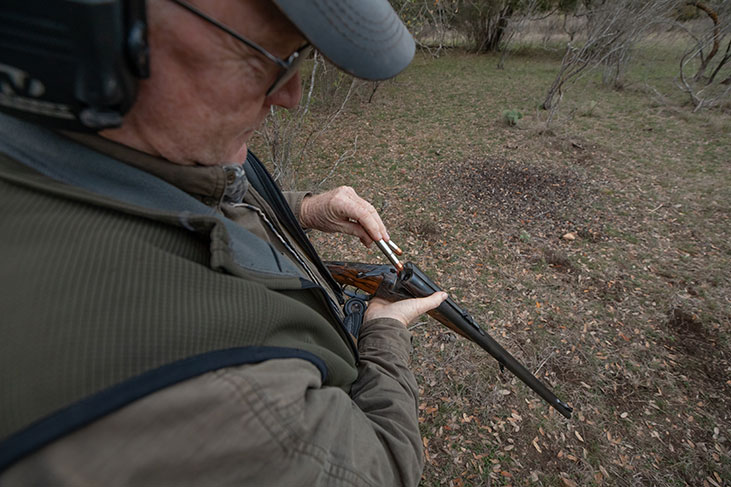
The biggest problem I’ve had getting an older double to shoot has been my little .303. Made in 1895, I have no idea the velocity of its original Cordite load with 215-grain bullet. I got it with some old Peters 215-grain ammo that shoots well, along with old 215-grain bullets. I matched the velocity and accuracy was fine. However, modern bullets of that weight are scarce, so the goal was to find a load that would regulate with Hornady 174-grain .312-inch bullets.
I tried this and that, hopeless, and then, bingo, RL15 put both barrels side-by-side at 50 yards. Except: The impact was three inches right and there is no windage adjustment in the pop-up aperture sight. In the same batch of trial loads, I also had a charge of IMR4064 at about the same velocity (2,200 fps). Regulation was not as good as with RL15, the strikes about an inch apart at 50 yards. In a 125-year-old rifle, fine. Amazingly, the different powder moved the strikes from three inches right to dead center. Done! I haven’t encountered anything quite like that, but Editor Steve Comus tells me it’s not unusual. I just got lucky, but we’re never too old to learn and, with older doubles, don’t give up!–Craig Boddington

